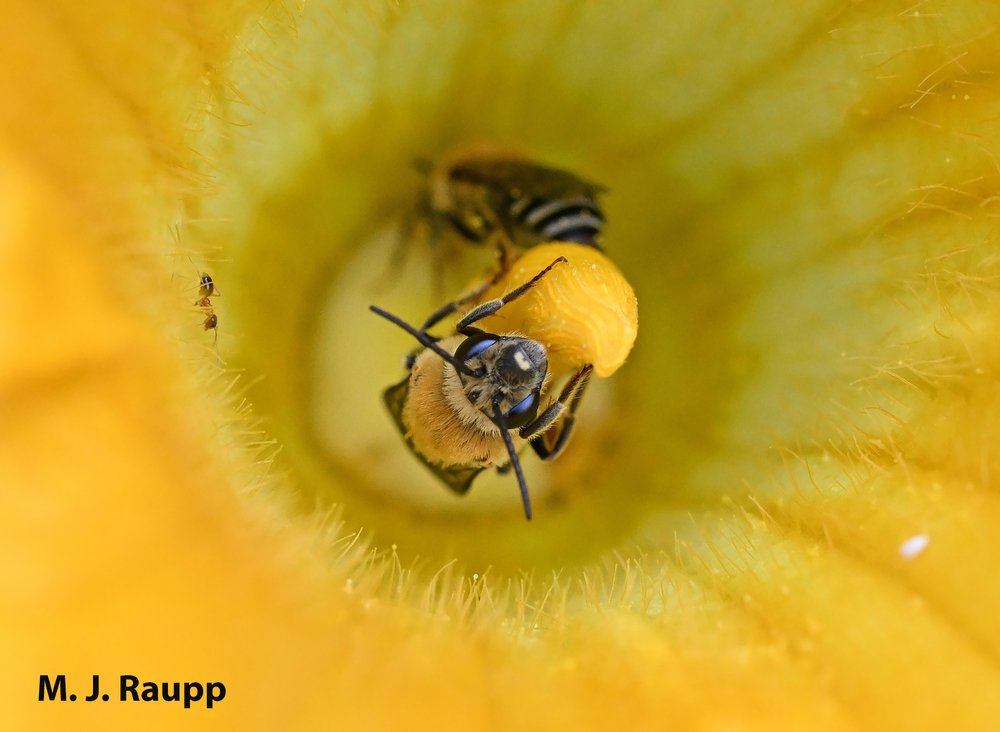
Good morning, sir! A male eastern cucurbit bee greets the camera while another gathers food in a pumpkin blossom.
Each year I try to grow pumpkins in my suburban landscape in Columbia, MD. Each year roving gangs of white-tailed deer invade my landscape and pillage my pumpkins despite my best attempts to shoo them away or assuage their damage by dousing my pumpkins with deer repellent. One morning last week, shortly after sunrise, while mourning the loss of yet another batch of pumpkin leaves, I was fascinated by clusters of solitary bees jockeying for position to gather nectar and pollen from newly opened blossoms of pumpkins. One of the most entertaining was the eastern cucurbit bee, Peponapis pruinosa. The genus name Peponapis literally means “pumpkin bee.” Sometimes as many as four of these rascals with their stripy abdomens tussled for access to nectaries deep inside the blossom. These wonderful bees are specialists, collecting pollen only from members of the squash family. Females construct burrows in soil a foot or more in depth and prepare several brood chambers along the gallery. Each chamber is provisioned with pollen and nectar to feed the developing young. Larvae develop through summer and autumn and emerge next spring when squash, pumpkins, and other cucurbits start to bloom. While females toil to build their subterranean nurseries, when blossoms close in the mid-morning heat, males can sometimes be found resting inside closed blossoms. These native bees evolved to pollinate their cucurbit hosts and can be found from Canada to Mexico.
Early one morning I stopped by my pumpkin patch and caught a glimpse of eastern cucurbit bees mobbing pumpkin blossoms. They were gathering nectar and pollen to feed their young. Nearby, a two-spotted longhorn bee tidied up a bit before moving to another blossom. Look at the size of her pollen loads. Her legs look like saddlebags. Wow!

A female two-spotted longhorn bee shares a blossom with an eastern cucurbit bee at dawn.
Zooming about my pumpkin patch, but not as numerous as Peponapis, was a gorgeous black bee with smokey black wings and two white tufts of hairs on its abdomen. Melissodes bimaculatus goes by the name of two-spotted longhorn bee. Unlike Peponapis, this native solitary bee is more of a generalist. I often see it gathering nectar and pollen from my cone flowers and other members of the aster family in addition to its sorties at my pumpkins. Hind legs of female bees are festooned with stout hairs called scopa which are used to collect pollen. When fully loaded they look like yellow saddle bags. Like Peponapis, female two-spotted longhorn bees tunnel in the soil and provision brood chambers with nectar and pollen to feed their young. Although these are solitary bees, they often form large aggregations of nests in areas with loose soils that they prefer.
If you grow pumpkins, squash, zucchini, or cucumbers and you live in the eastern US, grab your cup of coffee and head to the cucurbit patch early in the morning to enjoy these entertaining and beautiful native pollinators.
Acknowledgements
Bug of the Week thanks Sam Droege for generously taking time to identify the heroes of this episode. Information about the bees featured this week came from Tufts Pollinator Initiative, and Joseph S. Wilson and Olivia Messinger Carril’s amazing book “The Bees in Your Backyard”.
No comments:
Post a Comment